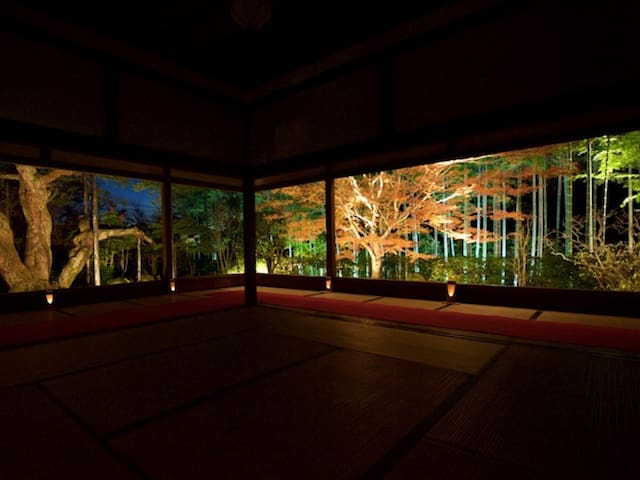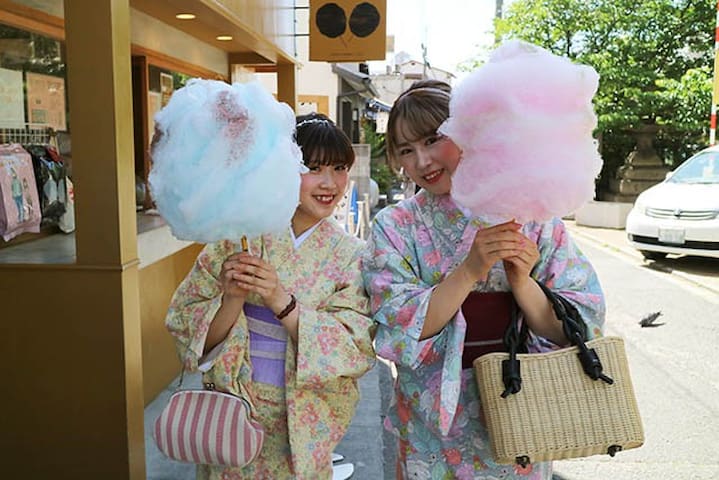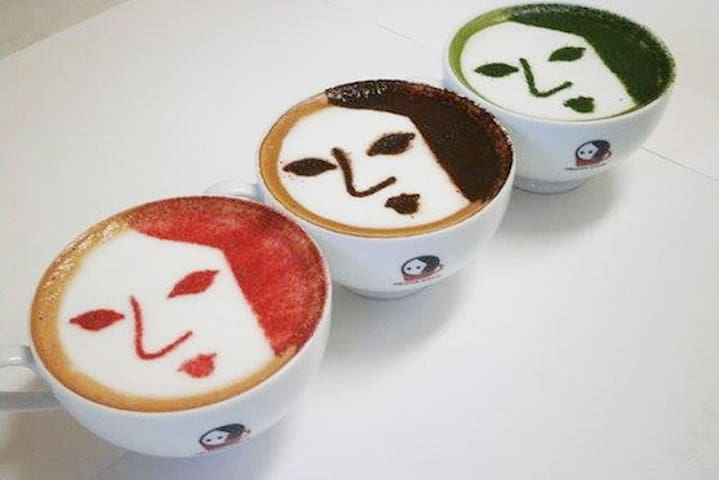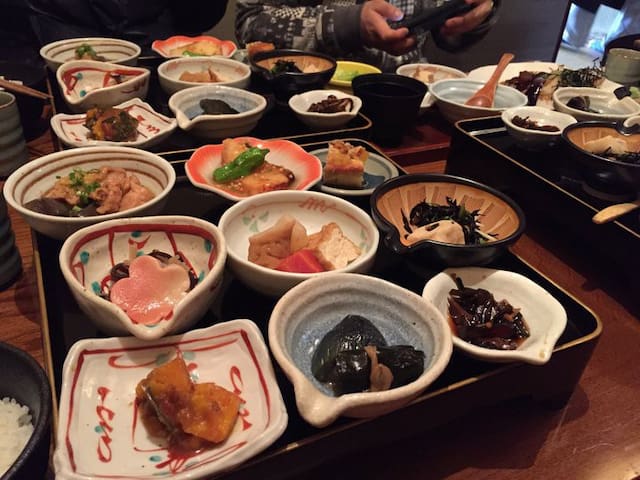観光
Nishi Honganji and Higashi Honganji in Kyoto are the two head temples of the Jodo-Shin Sect, one of Japan’s largest Buddhist sects. Nishi Honganji, designated as a World Cultural Heritage site, boasts several surviving masterpieces of architecture from the Azuchi-Momoyama and early Edo periods, including the Karamon (National Treasure of Japan), a four-legged gate with karahafu gables of undulating curves on the front and back. Higashi Honganji, built eleven years after Nishi Honganji, boasts the Goeido, Kyoto’s largest wooden building dedicated to the sect’s founder Shinran, and Shoseien, a small beautiful Japanese strolling-style garden with a pond.
365 lokale anbefaler
Nishihongwan-ji-templet
本願寺門前町 下京区Nishi Honganji and Higashi Honganji in Kyoto are the two head temples of the Jodo-Shin Sect, one of Japan’s largest Buddhist sects. Nishi Honganji, designated as a World Cultural Heritage site, boasts several surviving masterpieces of architecture from the Azuchi-Momoyama and early Edo periods, including the Karamon (National Treasure of Japan), a four-legged gate with karahafu gables of undulating curves on the front and back. Higashi Honganji, built eleven years after Nishi Honganji, boasts the Goeido, Kyoto’s largest wooden building dedicated to the sect’s founder Shinran, and Shoseien, a small beautiful Japanese strolling-style garden with a pond.
Yasaka Koshindo Temple (八坂庚申堂)
Yasaka Koshindo Temple (full name is Daikoku-san Kongo-ji Koshin-do (大黒山金剛寺庚申堂 ) is a small temple located in Higashiyama area in Kyoto. The temple is close by the famous “Kiyomizu dera” temple.
Yasakakoshido has unique way to worship. Worshippers write their wish on colourful ball called “kukurizaru” and hang them at the site. Kukurizaru is the round, ball shaped talisman made of cloth, representing the good faith monkeys. It is believed that if you give up with one of your greeds, one of your wish may come true. The best known divine favour of this temple is for “love knot”.
Those multi-coloured kukurizarus holding the wishes of love create the ordinary temple to a vivid wonderland. Visit Yasakakoshindo Temple, the most colourful and photogenic temple in Kyoto!
23 lokale anbefaler
Yasaka Koshin-Do
390 KinenchōYasaka Koshindo Temple (八坂庚申堂)
Yasaka Koshindo Temple (full name is Daikoku-san Kongo-ji Koshin-do (大黒山金剛寺庚申堂 ) is a small temple located in Higashiyama area in Kyoto. The temple is close by the famous “Kiyomizu dera” temple.
Yasakakoshido has unique way to worship. Worshippers write their wish on colourful ball called “kukurizaru” and hang them at the site. Kukurizaru is the round, ball shaped talisman made of cloth, representing the good faith monkeys. It is believed that if you give up with one of your greeds, one of your wish may come true. The best known divine favour of this temple is for “love knot”.
Those multi-coloured kukurizarus holding the wishes of love create the ordinary temple to a vivid wonderland. Visit Yasakakoshindo Temple, the most colourful and photogenic temple in Kyoto!
Hosen-in in Ohara to the north east of Kyoto is known for the beauty of its spectacularly tranquil garden and autumn foliage in season.
Hosen-in Temple is a sub-temple of nearby Shorin-in, like neighboring Jikko-in Temple, and is a Tendai sect temple of Japanese Buddhism.
Hosen-in is also one of the so-called "Bloody Temples of Kyoto," with part of its ceiling made up of blood-stained wooden floorboards taken from Fushimi Castle after its last defenders, loyal to warlord Ieyasu Tokugawa, committed ritual suicide when the castle was stormed in 1600.
7 lokale anbefaler
Hosenin
187 ŌharashōrininchōHosen-in in Ohara to the north east of Kyoto is known for the beauty of its spectacularly tranquil garden and autumn foliage in season.
Hosen-in Temple is a sub-temple of nearby Shorin-in, like neighboring Jikko-in Temple, and is a Tendai sect temple of Japanese Buddhism.
Hosen-in is also one of the so-called "Bloody Temples of Kyoto," with part of its ceiling made up of blood-stained wooden floorboards taken from Fushimi Castle after its last defenders, loyal to warlord Ieyasu Tokugawa, committed ritual suicide when the castle was stormed in 1600.
グルメシーン
%Arabica Kyoto is a must visit while in Kyoto. A stone’s throw from Hokanji temple sits this coffee shop designed so well that is impossible to walk past – it really does just strike you. It fits in beautifully when you imagine what Kyoto is like.
9 lokale anbefaler
Arabika
%Arabica Kyoto is a must visit while in Kyoto. A stone’s throw from Hokanji temple sits this coffee shop designed so well that is impossible to walk past – it really does just strike you. It fits in beautifully when you imagine what Kyoto is like.
JEREMY&JEMIMAH
51-4 ShimobentenchōCotton candy :)
On the first floor, locally-made kimono silk scrolls adorn the walls, while a picturesque garden comes complete with stone water basins and sculptures.
Upstairs, three more rooms provide tatami mat seating on the floor, and per tradition, customers are asked remove their shoes and sit on cushions. It also includes a bench for those who unable to sit on the floor.
Outside, rather than a Starbucks sign to indicate its location, the café has opted for deep green noren door curtains that bear the company logo.
“Walking through the noren at the entrance and venturing inside, we want customers to experience a feeling of being inside a traditional Kyoto machiya wooden townhouse,” Takafumi Minaguchi, chief executive of Starbucks Coffee Japan, told CNN.
28 lokale anbefaler
Starbucks Coffee Kyoto Nineizaka-Yasaka-Chaya
349 MasuyachōOn the first floor, locally-made kimono silk scrolls adorn the walls, while a picturesque garden comes complete with stone water basins and sculptures.
Upstairs, three more rooms provide tatami mat seating on the floor, and per tradition, customers are asked remove their shoes and sit on cushions. It also includes a bench for those who unable to sit on the floor.
Outside, rather than a Starbucks sign to indicate its location, the café has opted for deep green noren door curtains that bear the company logo.
“Walking through the noren at the entrance and venturing inside, we want customers to experience a feeling of being inside a traditional Kyoto machiya wooden townhouse,” Takafumi Minaguchi, chief executive of Starbucks Coffee Japan, told CNN.
While many people associate Yojiya with a Japanese cosmetics brand, but little do they know, this Kyoto business also has a chain of cute and chic cafés.
The café I would recommend is the original that sits not far from Ginkakuji Temple in Kyoto. What attracts people to wait in line for hours is the real Japanese atmosphere of the café, including tatami mat floors with cushions and sliding doors. The centerpiece is a glass wall, allowing guests to be seated facing a Japanese garden with Honen-in temple as a backdrop.
To sit down and enjoy a cup of hot green tea with some elaborate sweets that have a unique appearance and taste; add to that a serene view of a Japanese Garden with someone you love, it’s something that everyone would wish to do.
18 lokale anbefaler
Yojiya Cafe Ginkakuji
鹿ケ谷法然院町-15 左京区While many people associate Yojiya with a Japanese cosmetics brand, but little do they know, this Kyoto business also has a chain of cute and chic cafés.
The café I would recommend is the original that sits not far from Ginkakuji Temple in Kyoto. What attracts people to wait in line for hours is the real Japanese atmosphere of the café, including tatami mat floors with cushions and sliding doors. The centerpiece is a glass wall, allowing guests to be seated facing a Japanese garden with Honen-in temple as a backdrop.
To sit down and enjoy a cup of hot green tea with some elaborate sweets that have a unique appearance and taste; add to that a serene view of a Japanese Garden with someone you love, it’s something that everyone would wish to do.
The word for home cooking in Kyoto dialect.
Recipes passed down through the generations feature seasonal ingredients.
13 lokale anbefaler
Okudohan
The word for home cooking in Kyoto dialect.
Recipes passed down through the generations feature seasonal ingredients.
Mamehachi
210-4 NabeyachōI really like this restraint :)





